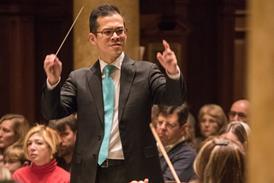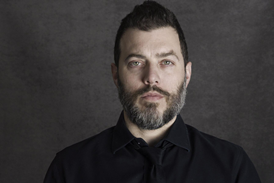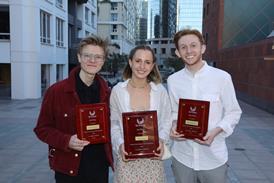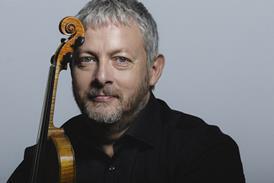The Russian musician was forced to withstand ten needle treatments to drain the recurring cyst – and was advised to keep playing throughout his ordeal

It’s a musician’s worst nightmare to wake up with a pain in his
hand. I had devoted the whole of my conscious life from the age of
five to a career as a professional violinist; there is nothing else
I know how to do. If there was a real problem with my hand, it
would literally mean the end of my life. And then one day it
appeared – a nagging ache, occasionally turning into a shooting
pain.
What did they tell us as children? If it hurts, stop playing
immediately, or you’ll only make it worse. Naturally, I stopped
practising immediately and got a doctor’s note for college. To give
the Royal College of Music administration their due, at this time
they were paying particular attention to the problem of what to do
with students suffering from hand pain, and they had a list of a
phone numbers for osteopaths in Harley Street and Alexander
Technique trainers, as well as a consultant specialising in
musicians’ injuries and hand injuries, Dr Ian Winspur.
Of everyone on the list, the name that leapt out at me was Winspur,
and I immediately called to make an appointment.
To get a bit ahead of myself, I should say that Dr Winspur is one
of the world’s leading specialists in hand pain among musicians.
One example will do: after my problem had been resolved, my
girlfriend at the time was performing a Shostakovich piano concerto
- the following day she felt some pain in her hand, specifically in
the tendon running along the thumb into the wrist. I took her along
to Dr Winspur, and the first thing he asked was:
‘What were you playing?’
‘Shostakovich’s first concerto.’
‘Ah, he does it every time! You have a strain that is usually found
among young mothers and female bassoonists…’
We looked at him in amazement. I asked:
‘But what’s the connection?’
‘The thing is that young mothers bend their hands when they hold
their baby, and female bassoonists get it from playing the key with
their thumb when the instrument isn’t designed for a woman’s small
hand but for a man’s. And both of them strain the same
tendon!’
But to get back to my own story… At that time I still knew nothing,
and to me he was simply a doctor I was seeing for the first time.
And the first thing he told me was, ‘Don’t stop playing!’
I looked at him in surprise.
‘When you stop playing, you stop using those tendons and they get
stiff. Then when the pain goes you start practicing furiously and
strain it even more, because the tendons have got out of the habit.
And then you quickly wreck your career. You need to play just a
little and make sure the pain doesn’t get worse. If the pain stays
the same you can carry on. If it gets worse you need to lessen the
load.’
‘But how long will it last?’
‘Maybe six months, maybe a year. Sometimes more.’ And he looked at
me calmly with an expression which told me quite clearly there was
nothing I could do but accept it.
Still, I wasn’t ready to give up so easily. A whole year? I hadn’t
got that much time! So I went for massage, then to an osteopath,
then to another, then to a Feldenkrais therapist. By this time a
little lump had appeared on my hand, which began to get bigger. A
sort of little ball, full of something or other.
Then I realised that all these clever people could cure only what
they knew about and not what I had. So they were trying to cure
things which actually had nothing to do with my problem. For
example, one of the osteopaths checked me over very carefully and
announced that my pelvis was crooked so that one leg was shorter
than the other and it needed to be straightened. I asked him
whether he was sure that the pain in my hand was connected with
that, and he said, ‘Yes, I think so!’
In the end, when I had spent enough time and money without seeing
any improvement, I decided to go back to the Winspur and find out
about this lump on my hand.
‘Ah, it’s a ganglion!’ he said, and then he explained what that
was.
A ganglion cyst is a fluid-filled swelling or lump that develops
under the skin, near a joint or a tendon. The cyst can range from
the size of a pea to the size of a golf ball. They are made up of a
thick, jelly-like fluid, called synovial fluid, which surrounds
joints and tendons to lubricate and cushion them during
movement.
‘There are two options – one, we pierce it with a needle and drain
the fluid, and two, you have an operation. If we do the first there
is a 50 per cent chance the ganglion will come back; with the
second there is about a 98 per cent chance it will never come back,
but it will take a while to heal.’
A few minutes later, for the first time, he gave me the treatment
called needle aspiration to drain the fluid. Naturally, the
ganglion came back after a while.
My brother Greg, a doctor based in New York, gave me some
entertaining information over the phone.
‘Do you know what the mediaeval cure was?’
‘No, what was it?’
‘Bashing the hand with the Bible. You know why they used the
Bible?’
‘Er, because they believed in its supernatural powers?’
‘No – it was because it was usually the heaviest book to
hand….’
I thought about the state of my hand after being smashed with a
heavy tome and sighed. It wasn’t the right solution for me.
Every so often I would go to see Dr Winspur, and he would drain the
fluid with his needle. In summer I found myself in New York and
decided to present myself to one more surgeon – I was beginning to
think this lump would keep coming back for ever – and he took a
look and said, ‘If you like we can operate, if it’s bothering
you.’
As for the reason for the ganglion’s appearance, he told me it came
from playing vibrato on the violin. I began to prepare for the
operation – then one day my brother suddenly remembered that I take
Roaccutane (a very strong acne treatment) – which meant it was
advisable to avoid operations because of the associated risk that
the drug could affect the healing process. So the operation was
cancelled.
I went back to Dr Winspur and told him I’d been in America, where
I’d been told the ganglion was a result of playing vibrato. He
said, ‘I know they say that – but they’re wrong. Statistically,
ganglions occur in ordinary people just as often as in
musicians.’
As time went by the ganglion got smaller and smaller, until at
length it disappeared completely. I’d had the needle treatment at
least ten times. The doctor stopped taking my money very soon after
the first consultation, perhaps because, as I subsequently
realised, my condition was rather rare. Years later, after I’d
recommended him to another person with similar symptoms, he told
her all about the violinist whose fluid he’d had to drain at least
ten times…
The most important thing I learned during the whole saga was: don’t
stop playing. And I got this from a doctor whose expertise I and
many friends had good reason to trust. Happily, thanks to my
experience, I was able to spare a number of others, including
musicians, unnecessary suffering by sending them to Dr Winspur –
and usually they needed only one or two treatments.
Roman Mints’ DANCE
OF SHADOWS is released on Quartz Music on 14 May 2014.
It includes the notable premiere of Dobrinka Tabakova’s Spinning a
Yarn, written especially by the composer for Mints as a gift to his
then unborn twins, Eva and Ilya.


























No comments yet